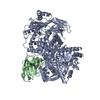+Search query
-Structure paper
| Title | Allosteric activation or inhibition of PI3Kγ mediated through conformational changes in the p110γ helical domain. |
|---|---|
| Journal, issue, pages | Elife, Vol. 12, Year 2023 |
| Publish date | Jul 7, 2023 |
 Authors Authors | Noah J Harris / Meredith L Jenkins / Sung-Eun Nam / Manoj K Rathinaswamy / Matthew A H Parson / Harish Ranga-Prasad / Udit Dalwadi / Brandon E Moeller / Eleanor Sheeky / Scott D Hansen / Calvin K Yip / John E Burke /   |
| PubMed Abstract | PI3Kγ is a critical immune signaling enzyme activated downstream of diverse cell surface molecules, including Ras, PKCβ activated by the IgE receptor, and Gβγ subunits released from activated ...PI3Kγ is a critical immune signaling enzyme activated downstream of diverse cell surface molecules, including Ras, PKCβ activated by the IgE receptor, and Gβγ subunits released from activated GPCRs. PI3Kγ can form two distinct complexes, with the p110γ catalytic subunit binding to either a p101 or p84 regulatory subunit, with these complexes being differentially activated by upstream stimuli. Here, using a combination of cryo electron microscopy, HDX-MS, and biochemical assays, we have identified novel roles of the helical domain of p110γ in regulating lipid kinase activity of distinct PI3Kγ complexes. We defined the molecular basis for how an allosteric inhibitory nanobody potently inhibits kinase activity through rigidifying the helical domain and regulatory motif of the kinase domain. The nanobody did not block either p110γ membrane recruitment or Ras/Gβγ binding, but instead decreased ATP turnover. We also identified that p110γ can be activated by dual PKCβ helical domain phosphorylation leading to partial unfolding of an N-terminal region of the helical domain. PKCβ phosphorylation is selective for p110γ-p84 compared to p110γ-p101, driven by differential dynamics of the helical domain of these different complexes. Nanobody binding prevented PKCβ-mediated phosphorylation. Overall, this work shows an unexpected allosteric regulatory role of the helical domain of p110γ that is distinct between p110γ-p84 and p110γ-p101 and reveals how this can be modulated by either phosphorylation or allosteric inhibitory binding partners. This opens possibilities of future allosteric inhibitor development for therapeutic intervention. |
 External links External links |  Elife / Elife /  PubMed:37417733 / PubMed:37417733 /  PubMed Central PubMed Central |
| Methods | EM (single particle) |
| Resolution | 2.96 Å |
| Structure data | EMDB-27627, PDB-8dp0: |
| Source |
|
 Keywords Keywords | TRANSFERASE/IMMUNE SYSTEM / PI3K / p110 / PIK3CG / phosphoinositide 3-kinase / PIP3 / TRANSFERASE-IMMUNE SYSTEM complex |
 Movie
Movie Controller
Controller Structure viewers
Structure viewers About Yorodumi Papers
About Yorodumi Papers





 homo sapiens (human)
homo sapiens (human)
